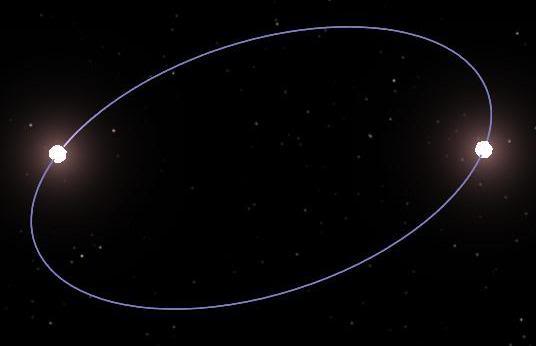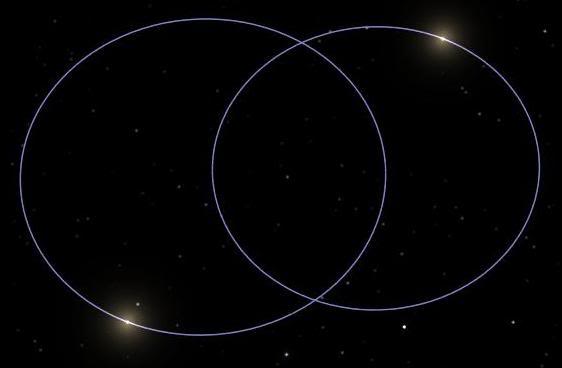Mezon
Micrometeorite


Number of posts : 10
Age : 31
Location : Axest(anagram)
Registration date : 2008-06-03
 |  Subject: "double orbit"? Subject: "double orbit"?  3rd June 2008, 9:55 pm 3rd June 2008, 9:55 pm | |
| I was thinking,(hypothetically) removing interfering gravity from other nearby celestial bodies, lets say you had two celestial bodies, exact same mass,diameter, etc and they were somehow able to move in opposite directions(they are side-by-side and are moving in a 'Z' formation) at the same speed and acceleration(if there is any at all). Based on this, would gravity be able to not only pull them back, but cause them to orbit around each other so they are(relative to a viewer of the orbit) forming a great circle(equator) of a sphere in their rotation?
Also please tell me if this is in the wrong forum. | |
|
Sirius_Alpha
Admin


Number of posts : 4320
Location : Earth
Registration date : 2008-04-06
 |  Subject: Re: "double orbit"? Subject: Re: "double orbit"?  3rd June 2008, 10:36 pm 3rd June 2008, 10:36 pm | |
| Hey, Mezon. =) Hmm, I am not 100% sure I understand the question, but I think I know what you're talking about. So I'll try to answer, and if it doesn't help much, let me know. Behold, the Ross 986 system, which is composed of two nearly identical red dwarf stars only 20 light years away. Both stars are of equal mass, so they orbit each other with identical orbits. Both of them move around the circle, orbiting each other.  Now if a binary star system is a bit different, whereas one star is more massive, it's orbit will be smaller. The more massive star has the most gravity, and is therefore able to throw around the smaller star easier. The massive star also has more intertia. Here's the 94 Ceti system (the primary star, 96 Ceti A, is known to have a gas planet). 94 Ceti is 73 light years away. The heaviest star, 94 Ceti A, is the one with the smaller orbit.  And yeah, those views are done with Celestia. | |
|
Mezon
Micrometeorite


Number of posts : 10
Age : 31
Location : Axest(anagram)
Registration date : 2008-06-03
 |  Subject: ah. Subject: ah.  4th June 2008, 2:40 pm 4th June 2008, 2:40 pm | |
| Now that I know such an orbit exists,I guess it would be possible for such an orbit to happen =P
_________________
If you cannot win an argument with an insane person... what happens if two insane people argue?
| |
|
Sirius_Alpha
Admin


Number of posts : 4320
Location : Earth
Registration date : 2008-04-06
 |  Subject: Re: "double orbit"? Subject: Re: "double orbit"?  4th June 2008, 3:07 pm 4th June 2008, 3:07 pm | |
| I'm glad I could help =). It's estimated that as much as half of the stars in the galaxy are in multiple-star systems. Most O stars seem to be in multiple star systems, and most M stars seem to be in single star systems. Perhaps it's related to the mass of the stars. An O type star has more mass and thus the disk it formed in had mroe mass, perhaps the leftovers are often enough to form another star. With M type stars, being low in mass, there's often not enough matter left over for the creation of a star.
One thing is for sure, more massive stars tend to have more massive planets. I don't know if this is a bias about our detection methods, or actual trends, but one hint comes in that red dwarfs tend to have few giant gas planets. If there was an abundance of gas planets around red dwarfs, it should be quite easy to detect. | |
|
Edasich
dK star


Number of posts : 2295
Location : Tau Ceti g - Mid Latitudes
Registration date : 2008-06-02
 |  Subject: Re: "double orbit"? Subject: Re: "double orbit"?  17th June 2008, 2:47 pm 17th June 2008, 2:47 pm | |
| Well, some (putative) Trojan planets should work a similar way. | |
|
Sponsored content
 |  Subject: Re: "double orbit"? Subject: Re: "double orbit"?  | |
| |
|
